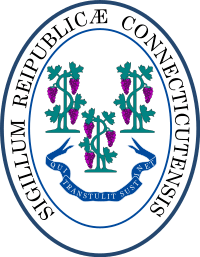Fundamental Orders of Connecticut
The Fundamental Orders were adopted by the Connecticut Colony council on January 14, 1639 OS (January 24, 1639 NS).[1][2] The fundamental orders describe the government set up by the Connecticut River towns, setting its structure and powers. They wanted the government to have access to the open ocean for trading.
The Orders have the features of a written constitution and are considered by one author to be the first written Constitution in the Western tradition, although the Mayflower compact has an equal claim 19 years before.[3] Thus, Connecticut earned its nickname of The Constitution State. Connecticut historian John Fiske was the first to claim that the Fundamental Orders were the first written Constitution, a claim disputed by some modern historians.[4] The orders were transcribed into the official colony records by the colony's secretary Thomas Welles. It was a Constitution the government that Massachusetts had set up. However, this Order gave men more voting rights and made more men eligible to run for elected positions.
History
In the year of 1635, a group of Puritans and others who were dissatisfied with the rate of Anglican reforms sought to establish an ecclesiastical society subject to their own rules and regulations. The Massachusetts General Court granted them permission to settle the cities of Windsor, Wethersfield, and Hartford.[5] Ownership of the land was called into dispute by the English holders of the Warwick Patent of 1631. The Massachusetts General Court established the March Commission to mediate the dispute, and named Roger Ludlow as its head. The Commission named eight magistrates from the Connecticut towns to implement a legal system. The March commission expired in March 1636, after which the settlers continued to self-govern.
On May 29, 1638, Ludlow wrote to Massachusetts Governor Winthrop that the colonists wanted to "unite ourselves to walk and lie peaceably and lovingly together." Ludlow and other principals drafted the Fundamental Orders, which were adopted on January 14, 1639 OS (January 24, 1639 NS) and established Connecticut as a self-ruled colony. Major John Mason was a magistrate and is credited with being one of the writers of this document.
There is no record of the debates or proceedings of the drafting or enactment of the Fundamental Orders. According to John Taylor:[6]. Puritans used to punish the townspeople for having different beliefs or wanting a new religion.
"The men of the three towns were a law unto themselves. It is known that they were in earnest for the establishment of a government on broad lines; and it is certain that the ministers and captains, the magistrates and men of affairs, forceful in the settlements from the beginning, were the men who took the lead, guided the discussions, and found the root of the whole matter in the first written declaration of independence in these historical orders."
Individual rights
The Fundamental Orders of Connecticut is a short document, but contains some principles that were later applied in creating the United States government. Government is based in the rights of an individual, and the orders spell out some of those rights, as well as how they are ensured by the government. It provides that all free men share in electing their magistrates, and uses secret, paper ballots. It states the powers of the government, and some limits within which that power is exercised.
In one sense, the Fundamental Orders were replaced by a Royal Charter in 1662, but the major outline of the charter was written in Connecticut and embodied the Orders' rights and mechanics. It was carried to England by Governor John Winthrop and basically approved by the British King, Charles II. The colonists generally viewed the charter as a continuation and surety for their Fundamental Orders. Later on, the Charter Oak got its name when that charter was taken from Jeremy Adams's tavern and supposedly hidden in an oak tree, rather than it be surrendered to the agents of James II, who intended to annex Connecticut to the more centralized Dominion of New England.
Today, the individual rights in the Orders, with others added over the years, are still included as a "Declaration of Rights" in the first article of the current Connecticut Constitution, adopted in 1965.
See also
Footnotes
- ↑ The January 14, 1639 date was in the old style Julian Calendar before conversion to the new style Gregorian Calendar. See Old Style and New Style dates for an explanation of the date adjustment.
- ↑ "The Columbia Encyclopedia" (Sixth ed.). ia University Press. 2005. Retrieved 2006-09-13.
- ↑ Lutz, Donald S.; Schechter, Stephen L.; Bernstein, Richard B. (1991). Roots of the Republic: American founding documents interpreted. Madison, Wis: Madison House. p. 24. ISBN 0-945612-19-2.
- ↑ Secretary of the State of Connecticut (2007). "STATE OF CONNECTICUT Sites º Seals º Symbols". the Connecticut State Register and Manual. State of Connecticut. Retrieved 2008-01-25.
- ↑ Horton, Wesley W. (1993-06-30). The Connecticut State Constitution: A Reference Guide. Reference guides to the state constitutions of the United States. no. 17. Westport, Connecticut: Greenwood Press. p. 2. ISBN 0-313-28565-9. OCLC 27066290. Retrieved 2008-09-17.
- ↑ Taylor, John M., Roger Ludlow the Colonial Lawmaker, 1900, Google Book Search
External links
| Wikisource has original text related to this article: |
